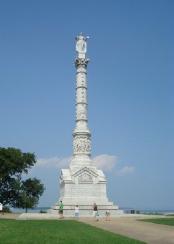

ExploreSouthernHistory.com - Battle of Yorktown, Virginia
ExploreSouthernHistory.com - Battle of Yorktown, Virginia

| Battle of Yorktown, Virginia A cannon of the Revolution aims out over the preserved siege lines where George Washington forced the surrender of Earl Charles Cornwallis. |
Yorktown VIctory Monument
The Battle of Yorktown was
the climactic victory of the
American Revolution and led
to the eventual end of the war.
The Battle of Yorktown was
the climactic victory of the
American Revolution and led
to the eventual end of the war.


The Blockaded River
The French fleet closed the
mouth of Chesapeake Bay
and blockaded the James
River, trapping the British at
Yorktown, Virginia.
The French fleet closed the
mouth of Chesapeake Bay
and blockaded the James
River, trapping the British at
Yorktown, Virginia.
Battle of Yorktown & Yorktown Battlefield - Yorktown, Virginia
Colonial National Historical Park

The Guns of History
The Battle of Yorktown forever
changed the course of human
history by assuring that the
United States would survive
as an independent nation.
The Battle of Yorktown forever
changed the course of human
history by assuring that the
United States would survive
as an independent nation.
| Copyright 2010 by Dale Cox All rights reserved. |

Other American Revolution Pages...
Battle of Cowpens - South Carolina
Battle of Kings Mountain - South Carolina
Battle of Ninety Six - South Carolina
Fort Moultrie - South Carolina
Battle of Arkansas Post - Arkansas
Battle of Fort Charlotte - Alabama
Battle of Pensacola - Florida
Fort George Historic Site - Florida
Castillo de San Marcos - Florida
Battle of Cowpens - South Carolina
Battle of Kings Mountain - South Carolina
Battle of Ninety Six - South Carolina
Fort Moultrie - South Carolina
Battle of Arkansas Post - Arkansas
Battle of Fort Charlotte - Alabama
Battle of Pensacola - Florida
Fort George Historic Site - Florida
Castillo de San Marcos - Florida



On the afternoon of October 19, 1781, the
British troops of Lord Charles Cornwallis
marched out from the fortifications of
Yorktown, Virginia, and surrendered their
arms. The Battle of Yorktown was over and
the British musicians played a then popular
tune named "The World Turned Upside
Down". And it indeed it had.
The Battle of Yorktown, Virginia, was the
climactic battle of the American Revolution. It
was not the last battle. Fighting would go on
for two more years. But it was so decisive
that the outcome was no longer in doubt. The
United States would survive as a nation and
human history would be forever changed.
General George Washington's opportunity for
a decisive victory developed after another
American General, Nathanial Greene, badly
battered the British troops under Cornwallis
during the famed "Race to the Dan" retreat
across North Carolina and the Battle of
Guilford Courthouse. Forced to withdraw to
the city of Wilmington on the North Carolina
coast to resupply, Cornwallis soon turned
north to Virginia and Yorktown.
A French fleet drove off a flotilla of British
ships and sealed the mouth of Chesapeake
Bay, giving 17,000 American and French
soldiers a chance to close in on Yorktown
and trap Cornwalli and his 8,300 men.
Realizing that he was trapped and
outnumbered roughly 2 to 1, Cornwallis
shorted his lines and abandoned exposed
positions, concentrating on an inner line of
fortifications that he hoped his men could
hold. Both sides dug in and set to work
building forts, batteries and breastworks. By
October 6, 1781, the siege of Yorktown was
underway.
On October 9th the French opened the allied
bombardment of Yorktown, with the American
guns quickly joining the action. In a noted
moment of American history, patriot Thomas
Nelson, Jr., asked allied artillery to shell his
own home. Nelson was a signer of the
Declaration of Independence who led militia
forces from Virginia during the Battle of
Yorktown. His house was believed to be
occupied by British officers and he urged its
destruction to assist the cause. The shell-
damaged house still stands today.
The battle escalated on October 14th when
the American and French forces stormed
British Redoubts No. 9 and No. 10. Allied
guns were moved dramatically closer to the
remaining British lines and the end was in
sight for General Lord Charles Cornwallis.
Fighting continued until October 17, 1781,
when a lone British drummer boy suddenly
appeared atop the Yorktown defenses and
began to beat the call for a parley.
British troops of Lord Charles Cornwallis
marched out from the fortifications of
Yorktown, Virginia, and surrendered their
arms. The Battle of Yorktown was over and
the British musicians played a then popular
tune named "The World Turned Upside
Down". And it indeed it had.
The Battle of Yorktown, Virginia, was the
climactic battle of the American Revolution. It
was not the last battle. Fighting would go on
for two more years. But it was so decisive
that the outcome was no longer in doubt. The
United States would survive as a nation and
human history would be forever changed.
General George Washington's opportunity for
a decisive victory developed after another
American General, Nathanial Greene, badly
battered the British troops under Cornwallis
during the famed "Race to the Dan" retreat
across North Carolina and the Battle of
Guilford Courthouse. Forced to withdraw to
the city of Wilmington on the North Carolina
coast to resupply, Cornwallis soon turned
north to Virginia and Yorktown.
A French fleet drove off a flotilla of British
ships and sealed the mouth of Chesapeake
Bay, giving 17,000 American and French
soldiers a chance to close in on Yorktown
and trap Cornwalli and his 8,300 men.
Realizing that he was trapped and
outnumbered roughly 2 to 1, Cornwallis
shorted his lines and abandoned exposed
positions, concentrating on an inner line of
fortifications that he hoped his men could
hold. Both sides dug in and set to work
building forts, batteries and breastworks. By
October 6, 1781, the siege of Yorktown was
underway.
On October 9th the French opened the allied
bombardment of Yorktown, with the American
guns quickly joining the action. In a noted
moment of American history, patriot Thomas
Nelson, Jr., asked allied artillery to shell his
own home. Nelson was a signer of the
Declaration of Independence who led militia
forces from Virginia during the Battle of
Yorktown. His house was believed to be
occupied by British officers and he urged its
destruction to assist the cause. The shell-
damaged house still stands today.
The battle escalated on October 14th when
the American and French forces stormed
British Redoubts No. 9 and No. 10. Allied
guns were moved dramatically closer to the
remaining British lines and the end was in
sight for General Lord Charles Cornwallis.
Fighting continued until October 17, 1781,
when a lone British drummer boy suddenly
appeared atop the Yorktown defenses and
began to beat the call for a parley.

One by one the American and French guns
fell silent. A British officer then stepped out
from his lines under a flag of truce and
walked forward across the deadly space that
divided the two armies. Allied officers met
him and, blindfolded, he was led to General
Washington's headquarters.
A cease-fire and negotiations followed. Then,
at 2 p.m. on October 19, 1781, the 9,000
American and 8,000 French soldiers lined up
facing each other. Cornwallis said was he
was ill, so British Brigadier General Charles
O'Hara led the King's army out of Yorktown.
Although it would take two more years to sign
the Treaty of Paris, there was little doubt now
left in anyone's mind that the United States of
America would be an independent nation.
The Yorktown Battlefield is now a beautifully
preserved part of Colonial National Historical
Park in Virginia. The visitor center features a
film, exhibits and an observation deck that
looks out over the field. Visitors can then take
a self-guided tour of the fortifications and
other key points of the battle. Please click
here to visit the official park service website
for more information.
The visitor center is open from 9 to 5 daily.
The battlefield closes daily at sunset. There
is a $10 entrance fee that is good for seven
days and covers both Yorktown and nearby
Jamestown. The park is located on the
Colonial Parkway. Please click here for full
directions.
fell silent. A British officer then stepped out
from his lines under a flag of truce and
walked forward across the deadly space that
divided the two armies. Allied officers met
him and, blindfolded, he was led to General
Washington's headquarters.
A cease-fire and negotiations followed. Then,
at 2 p.m. on October 19, 1781, the 9,000
American and 8,000 French soldiers lined up
facing each other. Cornwallis said was he
was ill, so British Brigadier General Charles
O'Hara led the King's army out of Yorktown.
Although it would take two more years to sign
the Treaty of Paris, there was little doubt now
left in anyone's mind that the United States of
America would be an independent nation.
The Yorktown Battlefield is now a beautifully
preserved part of Colonial National Historical
Park in Virginia. The visitor center features a
film, exhibits and an observation deck that
looks out over the field. Visitors can then take
a self-guided tour of the fortifications and
other key points of the battle. Please click
here to visit the official park service website
for more information.
The visitor center is open from 9 to 5 daily.
The battlefield closes daily at sunset. There
is a $10 entrance fee that is good for seven
days and covers both Yorktown and nearby
Jamestown. The park is located on the
Colonial Parkway. Please click here for full
directions.
Jamestown, Virginia
Appomattox Court House, Virginia
Arlington House, Virginia
Last Battle of the American Revolution
Forts & Battlefields of the South
Explore other Southern Historic Sites
Appomattox Court House, Virginia
Arlington House, Virginia
Last Battle of the American Revolution
Forts & Battlefields of the South
Explore other Southern Historic Sites
| Photos by Lauren Pitone |